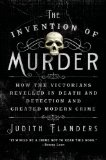Summary | Excerpt | Reviews | Beyond the Book | Readalikes | Genres & Themes | Author Bio

How the Victorians Revelled in Death and Detection and Created Modern Crime
by Judith Flanders
In the morning, a magistrate from the Thames Division Police Office took over the case. An officer from the Thames Division Police Office had responded the night before, and therefore the magistrates at the Thames Office were now in charge. A magistrate ordered the printing of handbills offering a reward, and visited the site of the murder, where the bodies lay where they had fallen the night before.
He was not the only one. What might be termed murder-sightseeing was a popular pastime, and many went 'from curiosity to examine the premises', where they entered 'and saw the dead bodies'. Inquests were held as quickly as possible after the event, usually at a public house or tavern near the scene of the crime. The bodies were left in situ for the jury to view. Until they had been, visitors traipsed through the gore-spattered rooms, peering not only at the blood splashes and other grisly reminders of the atrocity, but also at the bodies themselves.
For those who wanted a tangible souvenir, there were always broadsides, which were swiftly on sale on street corners. Broadsides had been around since the sixteenth century, but modern technology made their production easier, cheaper and quicker, and their distribution more widespread. A typical broadside was a single sheet, printed on one side, which was sold on the street for ½d. or 1d. Broadsides had their heyday before the 1850s, when newspapers were expensive. Most commonly, sheets were produced sequentially for each crime that caught the public's imagination: the first report of the crime, with further details as they were revealed; the magistrates' court hearing after an arrest; then the trial; and finally, and most profitably, a 'sorrowful lamentation' and 'last confession', usually combined with a description of the execution. These 'lamentations' and execution details were almost always entirely fabricated for commercial reasons: they found their readiest sale at the gallows, while the body was still swaying. For those who could not find a penny, pubs and coffee houses pinned up broadsides of popular crimes, to be read by customers as they drank. Other broadsides appeared in shop windows, frequently attracting crowds of bloodthirsty children.
One broadside, published before the Marrs' inquest, which opened three days after the murders, reported that 'the perpetrators are foreigners', which could have done little to reassure readers in this dockyard area of town, filled with sailors from across the world. Another spent less time on the possible murderer, and more on the gory details and the rumours that were prevalent: that Mrs Marr had, several months before, discharged a servant for theft. 'Words arose, when the accused girl is said to have held out a threat of murder. Mrs. Marr … gently rebuked her for using such language'; later Mrs Marr 'remonstrated with her on her loose character and hasty temper'. Anyone with a penny to spare would get a fair idea of the crime and the latest news of the search for the murderer.
Those with a few more pennies could buy a pamphlet on the subject. These were available nearly as swiftly as the broadsides. One covered all the details of the inquest, so it was probably on sale within five days of the deaths. While the pamphlets looked more substantial at eight pages, much of their information was identical to that in the broadsides. In some, such similar wording is used that either they must have shared an author, or one was copied from the other. Mrs Marr again sacks her servant, who 'is said to have held out a threat of murder. Mrs. Marr … gently rebuked her for using such language'; later she again 'remonstrated with her on her loose character and hasty temper'. Now, however, we get the additional detail that the servant was leading a 'prostituted life'. This is reinforced by a description of her clothes: 'a white gown, black velvet spencer [jacket], cottage bonnet with a small feather, and shoes with Grecian ties'. No servant could afford such fashionable items: they were signs that her money was earned immorally.
From Invention of Murder by Judith Flanders. Copyright © 2013 by the author and reprinted by permission of St. Martin's Press, LLC
Your guide toexceptional books
BookBrowse seeks out and recommends the best in contemporary fiction and nonfiction—books that not only engage and entertain but also deepen our understanding of ourselves and the world around us.